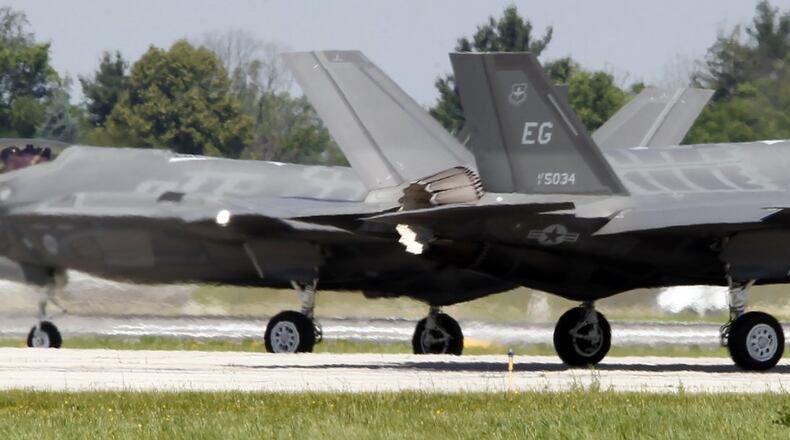“We really pale in comparison to (what) other states physically put into dollars,” said state House Speaker Cliff Rosenberger, R-Clarksville.
RELATED: Ohio leaders say funding wlll help protect Wright Patt
Rosenberger was among congressional, state and defense leaders at the Ohio Defense Forum in Columbus this week, the second year of the gathering. The Dayton Development Coalition, which marks Wright-Patterson and Springfield Air National Guard Base as top economic priorities, organized the forum.
U.S. Rep. Mike Turner, R-Dayton, said a BRAC was “imminent” and if not included in the pending version of a defense authorization bill in Congress would likely be in the next bill the following year.
The Pentagon has asked for a BRAC every year since 2013, and renewed that push as recently as last week, said George Schlossberg, general counsel to the Association of Defense Communities in Washington, D.C.
The Defense Department has cited a 19 percent excess capacity as one reason for the need, he added.
Communities that help bases operate more cost efficiently would likely have a hedge in a renewed BRAC round, said retired Air Force Reserve Maj. Gen Lou Ferraro, who worked with the Dayton Development Coalition in the 2005 BRAC to protect Wright-Patterson and the Springfield Air National Guard Base.
In that last of five prior BRAC rounds, Wright-Patterson gained more than 1,100 jobs, and the 711th Human Performance Wing and Sensors Directorate relocated to the Miami Valley base.
Turner said the Dayton region has prepared for years and is well positioned for a BRAC. But the state of Ohio needs to do more to support military bases, he said.
“The state needs to step up,” he said in an interview at the forum. “It is amazing what the gap is between what Ohio has and what Ohio spends to try to maintain those facilities.”
RELATED: Ohio universities target Air Force Research Lab for opportunities
In an interview, U.S. Rep. Brad Wenstrup, R-Cincinnati, who like Turner is a member of the House Armed Services Committee, said upcoming national security assessments should drive future BRAC outcomes.
“I think we need to have a long-term vision before we decide how we make any changes within our infrastructure before we really settle on what we do,” said Wenstrup, an Army Reserve doctor and a Iraq veteran. He added partnerships with industry might be one way to a more secure future for defense facilities in Ohio without spending more money out of the state budget.
Billions of defense dollars support tens of thousands of jobs in Ohio. Defense spending reached $6.9 billion, including contracts awarded, in fiscal year 2015, or a 1.7 percent share of the U.S. defense budget, the most recent year available based on Defense Department Office of Economic Adjustment data. Within Ohio, spending was highest in Montgomery County at $1.6 billion. Franklin County was second at $1.4 billion and Greene County — which like Montgomery is home to Wright-Patterson — was third with $1.3 billion, the data shows.
Ohio has more than 60,000 defense employees, including more than 27,000 at Wright-Patterson, the largest single-site employer in the state.
“We have a much bigger opportunity than we’ve been able to tap so far and I think the kind of collaboration that we’re able to do here (at the defense forum) sets the stage for us to get more momentum going not just for defense but for a lot of other things,” said U.S. Rep. Warren Davidson, R-Troy.
U.S. Rep. Marcy Kaptur, D-Toledo who has a fighter wing in her congressional district, said Ohio is at a disadvantage in competing against massive states like California for defense department dollars. The West Coast state, for example, has thousands more highly educated researchers and scientists and Ohio’s manufacturing legacy may not tie in with the Pentagon’s most recent technologies needs, she said.
In one area, Ohio leads other states, said Dennis Andersh, chief executive officer of the Wright State Applied Research Corp. The Ohio Federal Research Network represents a consortium of universities that created six “centers of excellence” to gain federal research dollars in work with agencies like the Air Force Research Laboratory at Wright-Patterson.
RELATED: Wright Patt loses out on a request for million in state dollars
The state has launched a BRAC and Military Affairs Task Force that will travel to each installation prior to the end of the year and, based on its findings, make recommendations, said state Rep. Rick Perales, R-Beavercreek, the task force’s chairman. “Other states are well ahead of us and I think everyone knows it,” he said at the forum. “ The state really wasn’t connecting with the installations.”
Ohio legislators set aside $500,000 — or $250,000 a year for two years — this year for infrastructure repairs at Wright-Patterson. The money was appropriated after Miami Valley area lawmakers were upset the Ohio Military Facilities Commission split $5 million between Ohio Air National Guard bases in Mansfield and Toledo and excluded Wright-Patterson, which had asked for a share of the funds.
Defense spending in Ohio
Total spent: $6.9 billion
Defense employees: More than 60,000
Percentage of U.S. defense budget: 1.7 percent
Defense dollars spent by county in fiscal year 2015:
Montgomery: $1.6 billion
Greene: $1.3 billion
Hamilton: $839.4 million
Butler: $85.3 million
Clark: $76.1 million
SOURCE: Department of Defense Office of Economic Adjustment, based on FY 2015 data
About the Author
